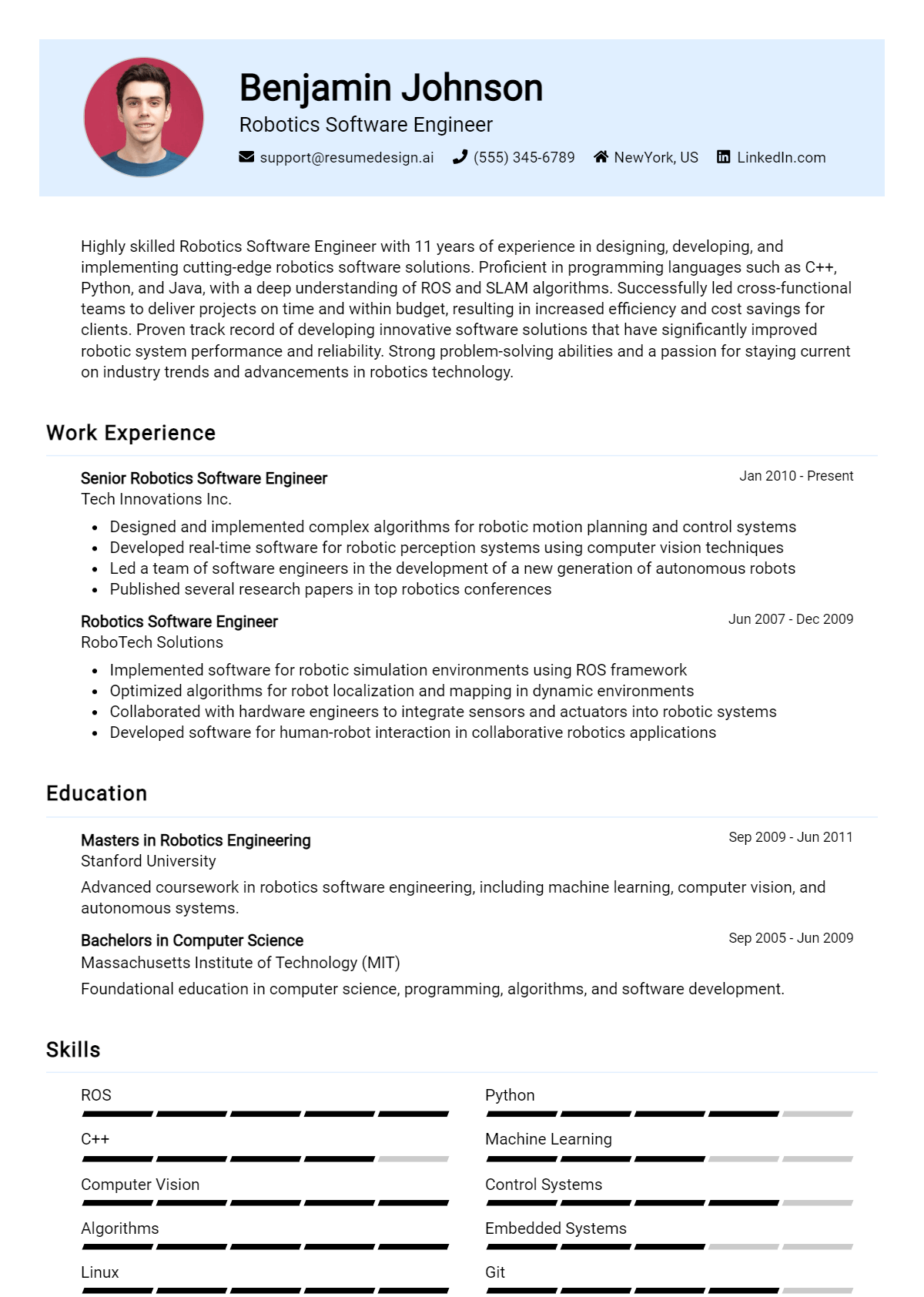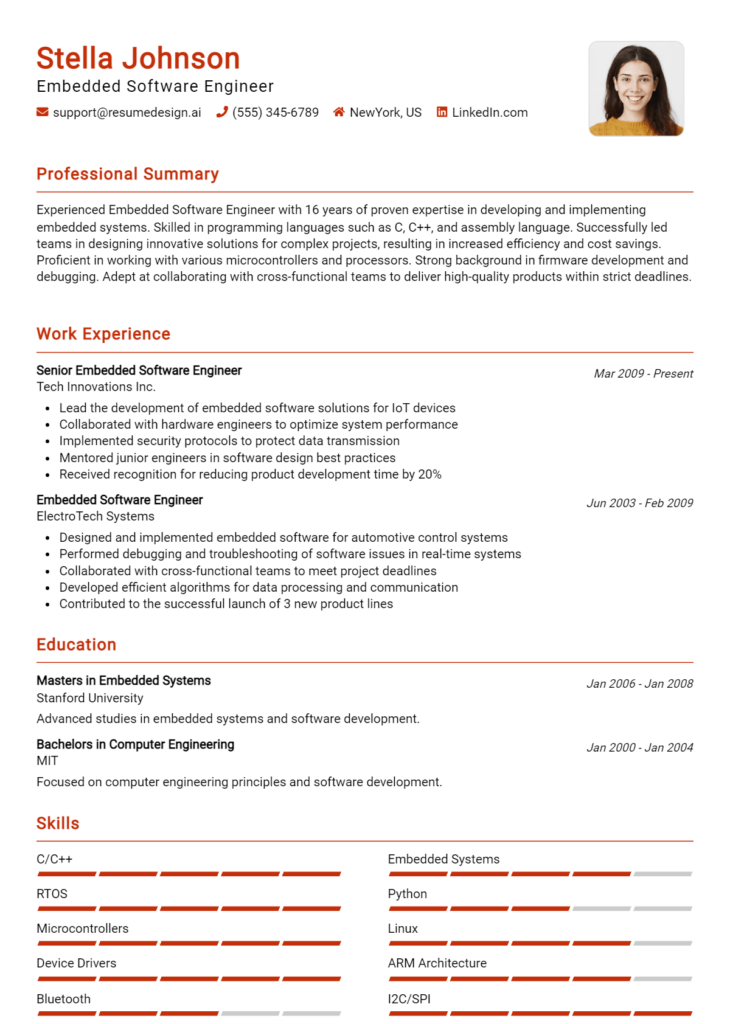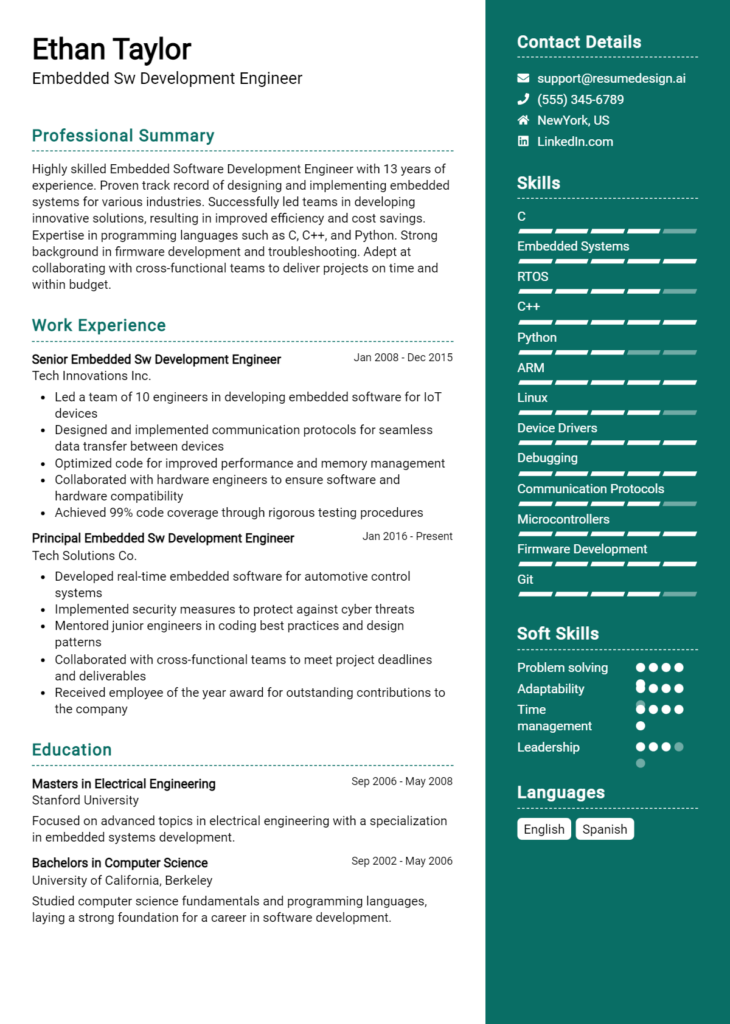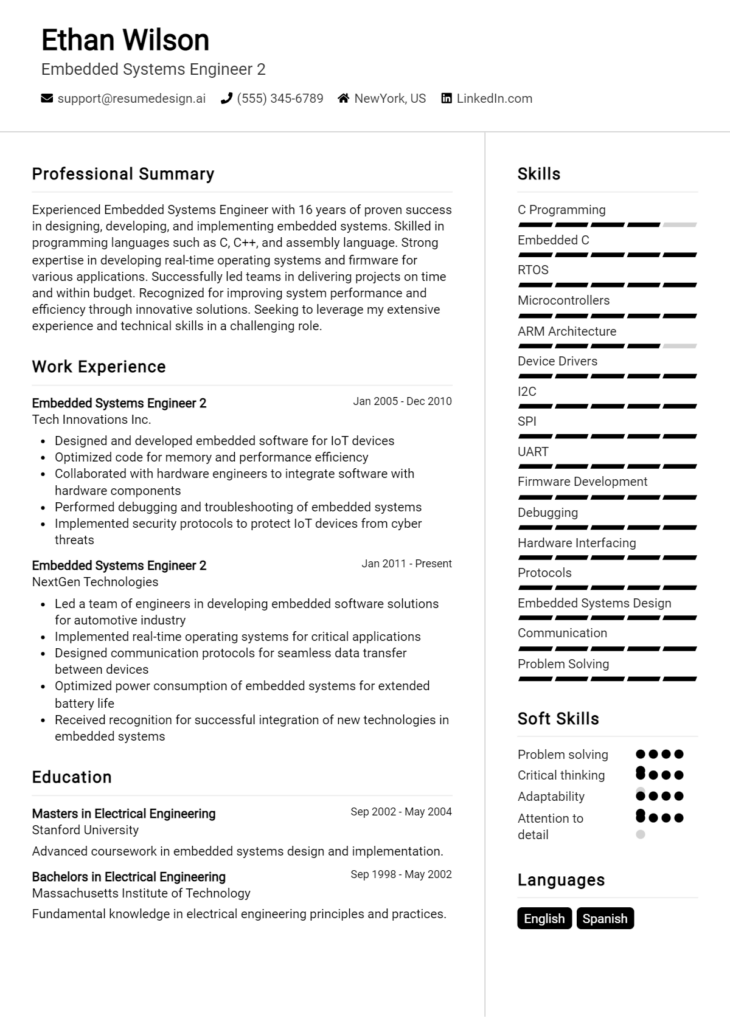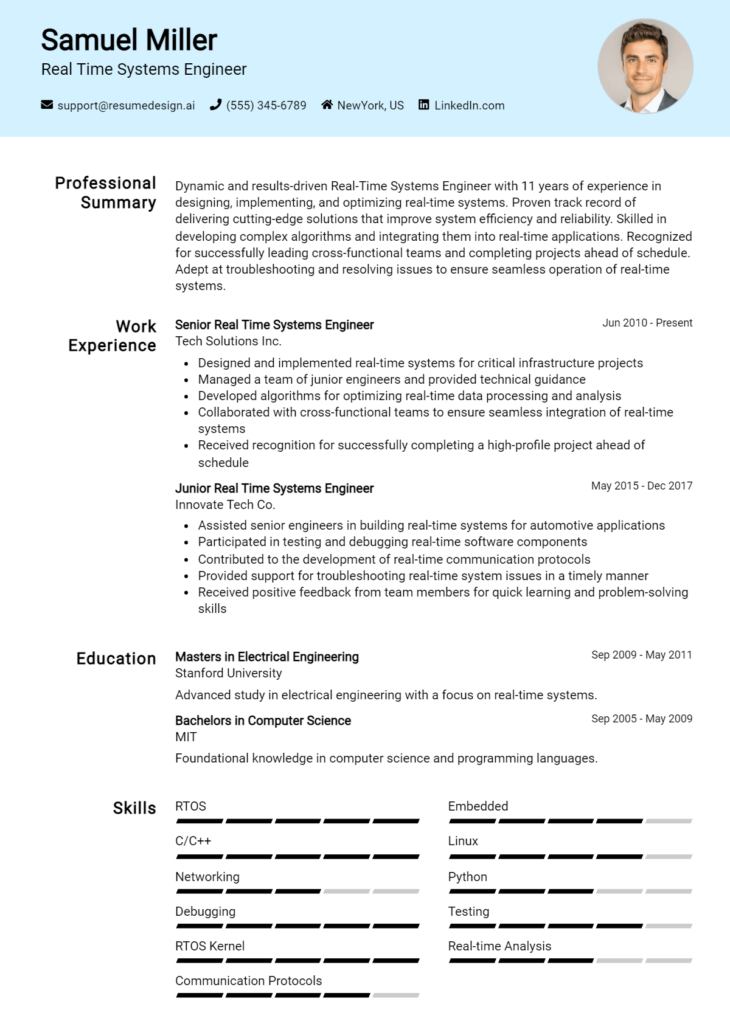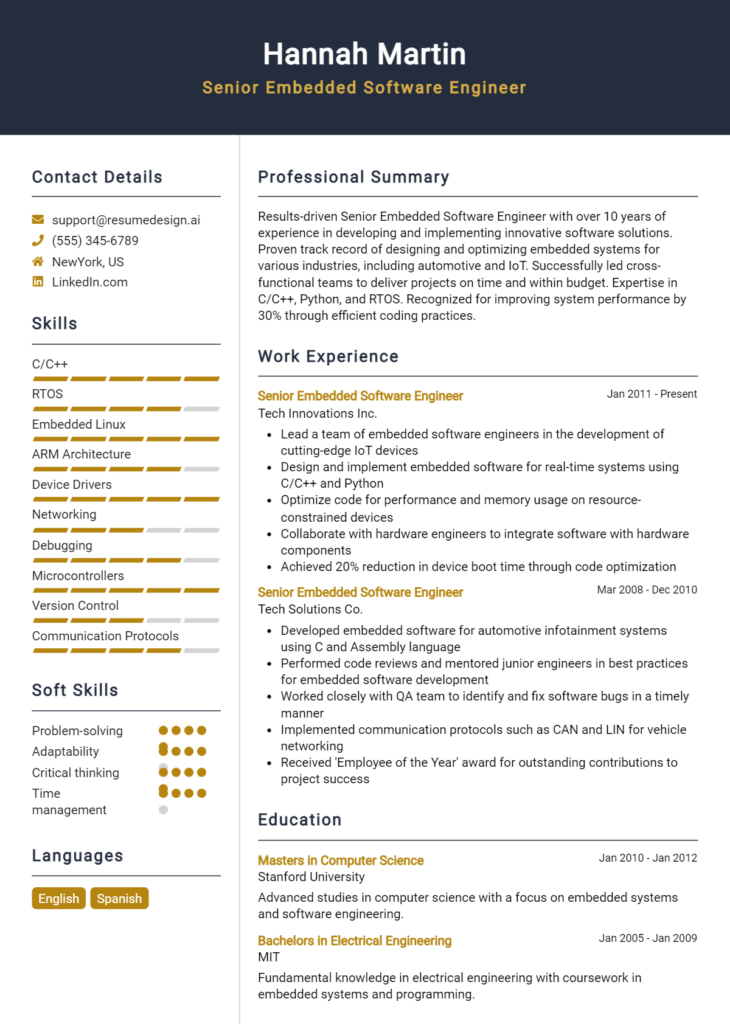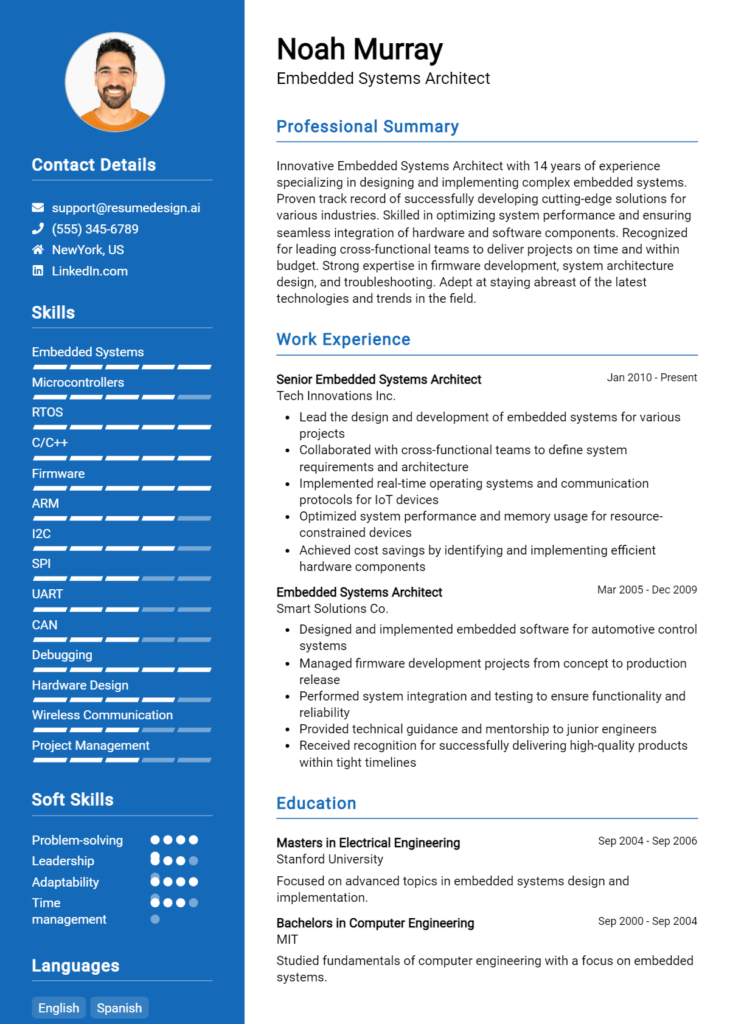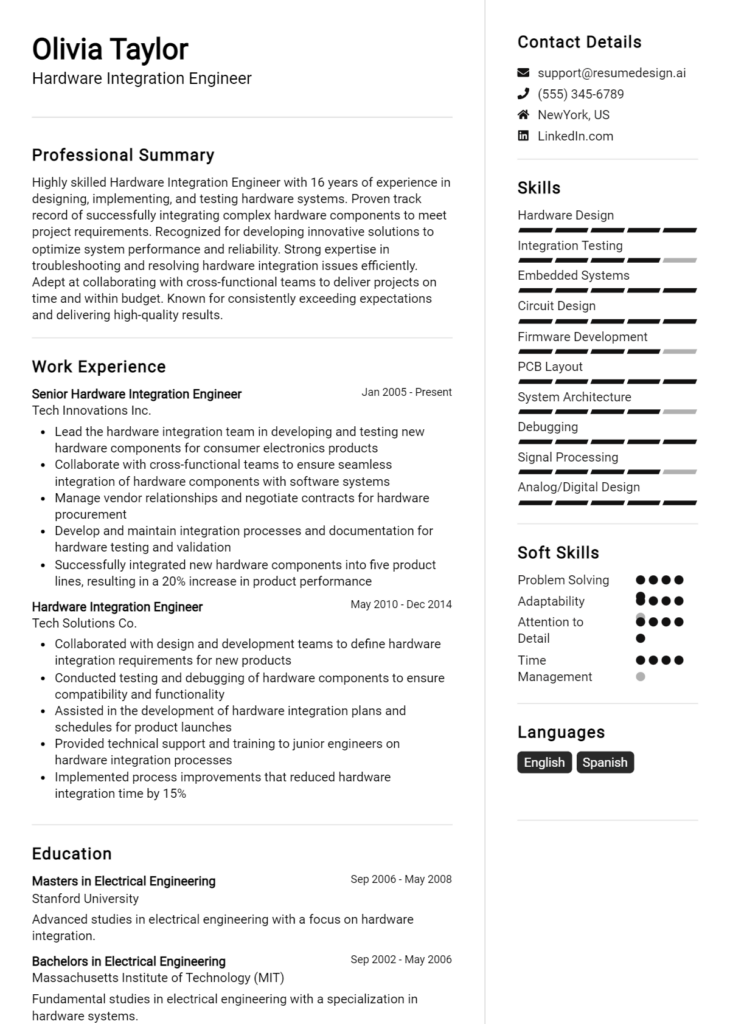Robotics Software Engineer Core Responsibilities
A Robotics Software Engineer plays a crucial role in developing and maintaining software systems that control robotic devices. Key responsibilities include designing algorithms, integrating sensors, and collaborating across departments such as hardware engineering and data analysis. Essential skills encompass strong programming knowledge, operational efficiency, and advanced problem-solving capabilities. These competencies are vital for aligning robotics projects with the organization's strategic goals. A well-structured resume can effectively highlight these qualifications, showcasing the engineer's potential impact.
Common Responsibilities Listed on Robotics Software Engineer Resume
- Designing and implementing robotic control algorithms.
- Developing software for sensor integration and data collection.
- Collaborating with hardware engineers to optimize system performance.
- Conducting simulations and testing to validate software functionality.
- Debugging and troubleshooting software issues in robotic systems.
- Documenting software architecture, design, and implementation processes.
- Participating in cross-functional team meetings and project planning.
- Staying current with advancements in robotics technology and software development.
- Contributing to the development of user interfaces for robotic applications.
- Ensuring compliance with industry standards and safety regulations.
- Providing technical support and training to end-users.
High-Level Resume Tips for Robotics Software Engineer Professionals
In the competitive field of robotics engineering, a well-crafted resume is not just a document; it’s often the first impression a candidate has on potential employers. For Robotics Software Engineer professionals, a resume needs to effectively reflect a blend of technical skills, relevant experience, and notable achievements. It serves as a critical tool to showcase your expertise in areas like software development, algorithm implementation, and systems integration. This guide will provide practical and actionable resume tips specifically tailored for Robotics Software Engineer professionals, helping you stand out in a crowded job market.
Top Resume Tips for Robotics Software Engineer Professionals
- Tailor your resume to the specific job description by incorporating relevant keywords and phrases that align with the job requirements.
- Highlight your technical skills, such as programming languages (e.g., Python, C++), software tools (e.g., ROS, Gazebo), and hardware knowledge.
- Showcase relevant experience, including internships, projects, and research, to demonstrate practical application of your skills in real-world scenarios.
- Quantify your achievements by using metrics to illustrate the impact of your work, such as performance improvements, efficiency gains, or successful project completions.
- Include a dedicated section for certifications and courses that are relevant to robotics, such as machine learning, computer vision, or control systems.
- Utilize clear and concise language, focusing on action verbs that convey your contributions, such as "developed," "implemented," or "designed."
- Prioritize the most relevant information at the top of your resume to capture the employer's attention quickly.
- Incorporate links to your online portfolio, GitHub, or relevant projects to provide tangible evidence of your skills and experience.
- Keep the layout clean and professional, ensuring that the document is easy to read and visually appealing.
- Proofread your resume multiple times to eliminate any grammatical errors or typos that could detract from your professionalism.
By implementing these tips, you can significantly enhance the quality of your resume, increasing your chances of landing a job in the Robotics Software Engineer field. A polished and targeted resume not only showcases your qualifications but also demonstrates your commitment to your career, making you a more attractive candidate to potential employers.
Why Resume Headlines & Titles are Important for Robotics Software Engineer
In the competitive field of robotics, a well-crafted resume headline or title is paramount for a Robotics Software Engineer. This concise, engaging phrase serves as the first impression for hiring managers, instantly capturing their attention and summarizing a candidate's key qualifications. A strong headline not only highlights relevant skills and experiences but also sets the tone for the rest of the resume, making it imperative that it is both relevant and impactful. By succinctly conveying expertise in robotics software development, candidates can differentiate themselves from the competition and increase their chances of landing an interview.
Best Practices for Crafting Resume Headlines for Robotics Software Engineer
- Keep it concise: Aim for a headline that is no more than 10-15 words.
- Be specific: Use terminology that directly relates to robotics and software engineering.
- Highlight key skills: Identify and showcase your most valuable skills relevant to the role.
- Incorporate metrics: Whenever possible, include quantifiable achievements in your headline.
- Tailor to job descriptions: Align your headline with the specific requirements of the job you are applying for.
- Use active language: Choose dynamic verbs and assertive phrases to convey confidence.
- Avoid clichés: Steer clear of generic phrases that do not add value to your resume.
- Showcase relevant experience: Mention any notable projects or positions that underscore your expertise.
Example Resume Headlines for Robotics Software Engineer
Strong Resume Headlines
"Innovative Robotics Software Engineer with 5+ Years in Autonomous Systems Development"
“Expert in Machine Learning Algorithms for Robotics Applications with Proven Track Record”
“Robotics Software Engineer Specializing in Real-Time Systems and Control Algorithms”
“Creative Problem Solver in Robotics, Focused on Enhancing AI-Driven Automation”
Weak Resume Headlines
“Software Engineer Looking for Opportunities”
“Experienced Engineer”
The strong headlines are effective because they are tailored, specific, and showcase the candidate's expertise in a way that resonates with the needs of the hiring manager. By incorporating relevant skills, roles, and achievements, these headlines immediately communicate value and relevance. In contrast, the weak headlines fail to impress because they lack specificity and do not provide any meaningful insight into the candidate's qualifications or abilities, making them easily forgettable in a sea of applications.
Writing an Exceptional Robotics Software Engineer Resume Summary
A well-crafted resume summary is crucial for a Robotics Software Engineer, as it serves as the first impression a hiring manager will have of a candidate's qualifications. A strong summary quickly captures attention by succinctly highlighting key skills, relevant experience, and notable accomplishments that align with the job role. This brief yet impactful section should be tailored specifically to the position being applied for, ensuring that it effectively communicates the candidate's unique value proposition and sets the tone for the rest of the resume.
Best Practices for Writing a Robotics Software Engineer Resume Summary
- Quantify Achievements: Use specific numbers to demonstrate your impact, such as projects completed, efficiency improvements, or cost savings.
- Focus on Skills: Highlight critical technical and soft skills that are relevant to the robotics field, such as programming languages, algorithms, or teamwork.
- Tailor to Job Description: Customize your summary for each application by incorporating keywords and phrases from the job listing.
- Be Concise: Aim for 2-4 sentences that clearly convey your strengths without being overly verbose.
- Showcase Relevant Experience: Briefly mention specific projects or roles that directly relate to the responsibilities of the position you’re applying for.
- Use Action Words: Start sentences with strong verbs that convey your contributions and achievements effectively.
- Maintain Professional Tone: Keep the language formal and professional to reflect your qualifications and expertise.
- Include Certifications: If applicable, mention any relevant certifications or training that enhance your qualifications in robotics.
Example Robotics Software Engineer Resume Summaries
Strong Resume Summaries
Innovative Robotics Software Engineer with over 5 years of experience in developing advanced algorithms for autonomous navigation systems, resulting in a 30% increase in operational efficiency. Proficient in ROS, C++, and Python, with a proven track record of leading cross-functional teams on multi-million dollar projects.
Detail-oriented Robotics Software Engineer skilled in machine learning and computer vision, having successfully implemented a vision-based control system that improved object recognition accuracy by 25%. Experienced in Agile methodologies and collaborating with diverse teams to deliver high-quality robotic solutions.
Results-driven Robotics Software Engineer with expertise in sensor integration and real-time data processing, achieving a 40% reduction in latency for robotic feedback loops. Adept at using simulation tools such as Gazebo and MATLAB to enhance robotic performance in challenging environments.
Weak Resume Summaries
Experienced software engineer with a background in robotics seeking opportunities in the field. Good at programming and working with robots.
Robotics Software Engineer with some experience in various projects. Interested in applying skills to new challenges.
The strong resume summaries are effective because they provide specific achievements, relevant skills, and a clear connection to the job role, demonstrating the candidate's capabilities and contributions in measurable terms. In contrast, the weak summaries lack detail and specificity, making them generic and unremarkable, which diminishes their impact on hiring managers looking for qualified candidates.
Work Experience Section for Robotics Software Engineer Resume
The work experience section of a Robotics Software Engineer resume is a critical component that highlights a candidate's technical skills, project management capabilities, and ability to produce high-quality products. This section serves not only to demonstrate hands-on experience with robotics systems and software but also to convey how the candidate has effectively led teams, collaborated with cross-functional partners, and contributed to the successful delivery of projects. By quantifying achievements and aligning the experience with industry standards, candidates can paint a clear picture of their value, making a compelling case for their candidacy.
Best Practices for Robotics Software Engineer Work Experience
- Use specific technical terminology relevant to robotics software engineering to demonstrate expertise.
- Quantify achievements with metrics (e.g., improved efficiency by 30%, reduced processing time by 50%).
- Highlight leadership roles, including team management and mentoring experiences.
- Showcase collaborative projects that involved cross-functional teams and stakeholders.
- Focus on relevant industry standards and technologies to ensure alignment with employer expectations.
- Include details about the programming languages, tools, and frameworks used in projects.
- Describe the impact of your contributions on the overall project outcome.
- Tailor the work experience to reflect the specific job description and desired qualifications of the role you are applying for.
Example Work Experiences for Robotics Software Engineer
Strong Experiences
- Led a team of 5 engineers in the development of an autonomous navigation system for mobile robots, resulting in a 40% increase in operational efficiency.
- Designed and implemented a robust software architecture for a robotic arm control system, reducing latency by 25% and improving precision in tasks.
- Collaborated with hardware engineers to integrate sensors and actuators, achieving a successful deployment that improved product reliability by 30%.
- Developed a simulation environment for testing algorithms, which decreased the debugging time by 50% and enhanced team productivity.
Weak Experiences
- Worked on various projects involving robotics software.
- Assisted in team tasks related to robot programming.
- Contributed to code development for different applications.
- Participated in meetings to discuss project ideas.
The examples provided illustrate a clear distinction between strong and weak experiences. Strong experiences are characterized by specific achievements, quantifiable impacts, and clear descriptions of leadership and collaboration, demonstrating not only technical expertise but also the ability to drive results. In contrast, weak experiences lack detail and specificity, making it difficult for potential employers to assess the candidate's true contributions and capabilities in the field of robotics software engineering.
Education and Certifications Section for Robotics Software Engineer Resume
The education and certifications section of a Robotics Software Engineer resume plays a crucial role in showcasing the candidate's academic qualifications and industry-relevant expertise. This section not only highlights the formal education that provides the foundational knowledge necessary for a career in robotics, but it also emphasizes any certifications that reflect specialized skills and continuous learning efforts in this rapidly evolving field. By including relevant coursework, certifications, and specialized training, candidates can significantly enhance their credibility and demonstrate alignment with the specific requirements of the job role, setting themselves apart in a competitive job market.
Best Practices for Robotics Software Engineer Education and Certifications
- Prioritize relevant degrees, such as a Bachelor’s or Master’s in Robotics, Computer Science, or Engineering.
- Include industry-recognized certifications, such as ROS (Robot Operating System) certification or Certified Robotics Technician.
- Detail specific coursework related to robotics, machine learning, artificial intelligence, and control systems.
- Highlight any specialized training or workshops that demonstrate advanced skills or new technologies in robotics.
- Ensure the section is well-organized, using bullet points for clarity and easy readability.
- Keep information current and remove outdated certifications that may no longer be relevant.
- Consider including GPA or honors for academic achievements if they are particularly strong.
- Tailor this section for each job application, emphasizing the most relevant qualifications for the specific role.
Example Education and Certifications for Robotics Software Engineer
Strong Examples
- Bachelor of Science in Robotics Engineering, University of Technology, 2021
- Certified Robotics Technician (CRT), Robotics Certification Standards Alliance, 2022
- Relevant Coursework: Advanced Robotics, Machine Learning, Computer Vision, and Control Systems.
- Master of Science in Artificial Intelligence, Institute of Robotics, 2023
Weak Examples
- Bachelor of Arts in History, Local University, 2015
- Certification in Basic Microsoft Office, Online Course, 2020
- Relevant Coursework: Introduction to Psychology, Community Development.
- High School Diploma, General Studies, 2010
The examples listed as strong reflect education and certifications that are directly relevant to the field of robotics, demonstrating a clear investment in the candidate's knowledge and skills applicable to the role. In contrast, the weak examples indicate qualifications that are either unrelated to robotics or do not reflect the necessary advanced skills required in the industry, ultimately diminishing the candidate's appeal for a Robotics Software Engineer position.
Top Skills & Keywords for Robotics Software Engineer Resume
As a Robotics Software Engineer, showcasing the right set of skills on your resume is crucial for standing out in a competitive job market. Employers look for candidates who possess both technical expertise and interpersonal abilities, as these skills are vital for effectively collaborating in multidisciplinary teams and driving innovative solutions. A well-rounded skill set not only highlights your qualifications but also reflects your capability to adapt to the ever-evolving landscape of robotics technology. By carefully curating your skills section, you can ensure that your resume resonates with hiring managers and aligns with the specific demands of the role.
Top Hard & Soft Skills for Robotics Software Engineer
Soft Skills
- Problem-solving
- Team collaboration
- Communication
- Adaptability
- Critical thinking
- Creativity
- Time management
- Attention to detail
- Leadership
- Conflict resolution
Hard Skills
- Proficiency in programming languages (e.g., C++, Python, Java)
- Familiarity with robotics frameworks (e.g., ROS, Gazebo)
- Knowledge of machine learning algorithms
- Experience with embedded systems
- Understanding of control systems and dynamics
- Proficiency in simulation and modeling tools
- Familiarity with computer vision techniques
- Experience in software development methodologies (e.g., Agile, Scrum)
- Knowledge of sensor integration
- Proficiency in version control systems (e.g., Git)
For more insights on how to effectively present your skills and work experience, consider refining your resume to showcase your strengths as a Robotics Software Engineer.
Stand Out with a Winning Robotics Software Engineer Cover Letter
I am writing to express my interest in the Robotics Software Engineer position at [Company Name], as advertised on [where you found the job listing]. With a robust background in robotics, software development, and a passion for innovative technology solutions, I am excited about the opportunity to contribute to your team. My experience in designing and implementing robotic software systems, coupled with my commitment to continuous learning and improvement, aligns well with the goals of your organization.
During my time at [Previous Company Name], I successfully led a project focused on developing autonomous navigation algorithms for mobile robots. This involved extensive programming in C++ and Python, as well as using ROS (Robot Operating System) to facilitate seamless communication between hardware components and software modules. My efforts resulted in a 30% increase in navigation efficiency, which was well received by stakeholders and improved the overall functionality of our robotic systems. I thrive in collaborative environments and enjoy working closely with cross-functional teams to deliver innovative solutions that meet complex challenges.
I hold a Master’s degree in Robotics from [University Name], where I conducted research on machine learning applications in robotic vision systems. This academic foundation, coupled with my hands-on experience in software development and integration, equips me with a unique skill set that I am eager to apply at [Company Name]. I am particularly impressed by your commitment to [mention any specific project or value of the company], and I am eager to bring my expertise in robotics software engineering to support your mission.
Thank you for considering my application. I am looking forward to the opportunity to discuss how my skills and experiences can contribute to the exciting projects at [Company Name]. I am enthusiastic about the potential to work with a talented team dedicated to pushing the boundaries of robotics technology. Please feel free to contact me at [Your Phone Number] or [Your Email Address] to arrange a conversation.
Common Mistakes to Avoid in a Robotics Software Engineer Resume
When crafting a resume for a Robotics Software Engineer position, it’s crucial to present your skills and experiences effectively. However, many candidates make common mistakes that can hinder their chances of landing an interview. Here are some pitfalls to avoid to ensure your resume stands out in the competitive field of robotics engineering:
Lack of Relevant Keywords: Failing to include industry-specific keywords can result in your resume being overlooked by applicant tracking systems (ATS). Tailor your resume to match the job description.
Generic Objective Statements: Using a one-size-fits-all objective statement can make your resume forgettable. Customize your objective to reflect your passion for robotics and the specific position.
Overloading with Technical Jargon: While it's important to showcase your technical skills, using too much jargon can alienate recruiters who may not have a technical background. Strike a balance between technical detail and clarity.
Neglecting Soft Skills: Focusing solely on technical abilities can leave out critical soft skills like teamwork, communication, and problem-solving. Highlighting these skills can provide a more rounded picture of your capabilities.
Inconsistent Formatting: A resume that is poorly formatted can be difficult to read and may give an impression of carelessness. Use consistent fonts, sizes, and spacing to enhance readability.
Ignoring Project Impact: Simply listing projects without discussing their impact or your specific contributions can weaken your resume. Quantify your achievements with metrics to demonstrate the significance of your work.
Listing Irrelevant Experience: Including unrelated work experience can clutter your resume and distract from your relevant skills. Focus on experiences that directly relate to robotics and software engineering.
Omitting Continuous Learning: In a rapidly evolving field like robotics, failing to mention ongoing education or certifications can make you seem stagnant. Highlight any relevant courses, workshops, or certifications to show your commitment to professional growth.
Conclusion
As we've explored in this article, the role of a Robotics Software Engineer is multifaceted and demands a strong blend of technical skills, creativity, and problem-solving abilities. Key responsibilities include designing software systems for robotic applications, programming in languages such as C++ and Python, and collaborating with interdisciplinary teams to integrate software with hardware. Additionally, staying updated with the latest advancements in robotics technology and methodologies is crucial for success in this field.
To position yourself effectively for opportunities in this competitive job market, it’s essential to craft a compelling resume that highlights your relevant experience, skills, and projects. Take a moment to review your Robotics Software Engineer resume to ensure it showcases your qualifications and aligns with industry expectations.
To assist you in this process, consider utilizing our array of resources. You can find resume templates that cater specifically to tech roles, a user-friendly resume builder to help you create a polished document, and resume examples that can inspire you to refine your own. Additionally, don’t overlook the importance of a strong introduction – check out our cover letter templates to complement your application.
Don’t wait! Elevate your job application today and take the next step toward your dream career as a Robotics Software Engineer.

